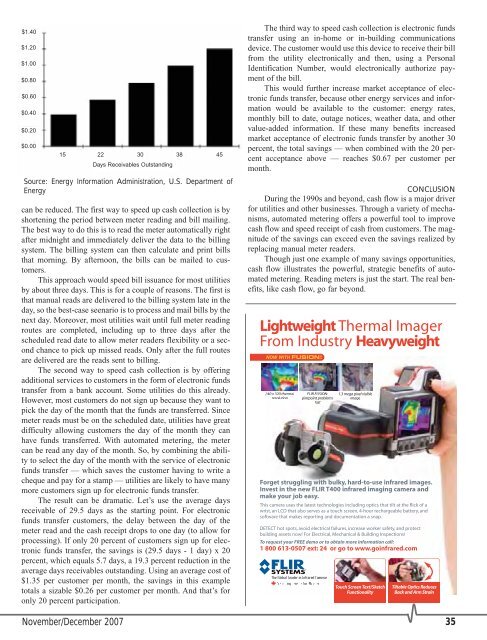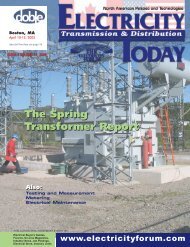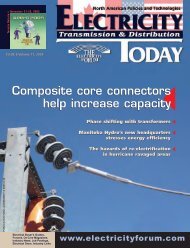in this issue - Electricity Today Magazine
in this issue - Electricity Today Magazine
in this issue - Electricity Today Magazine
Create successful ePaper yourself
Turn your PDF publications into a flip-book with our unique Google optimized e-Paper software.
$1.40<br />
$1.20<br />
$1.00<br />
$0.80<br />
$0.60<br />
$0.40<br />
$0.20<br />
$0.00<br />
15<br />
Source: Energy Information Adm<strong>in</strong>istration, U.S. Department of<br />
Energy<br />
can be reduced. The first way to speed up cash collection is by<br />
shorten<strong>in</strong>g the period between meter read<strong>in</strong>g and bill mail<strong>in</strong>g.<br />
The best way to do <strong>this</strong> is to read the meter automatically right<br />
after midnight and immediately deliver the data to the bill<strong>in</strong>g<br />
system. The bill<strong>in</strong>g system can then calculate and pr<strong>in</strong>t bills<br />
that morn<strong>in</strong>g. By afternoon, the bills can be mailed to customers.<br />
This approach would speed bill issuance for most utilities<br />
by about three days. This is for a couple of reasons. The first is<br />
that manual reads are delivered to the bill<strong>in</strong>g system late <strong>in</strong> the<br />
day, so the best-case seenario is to process and mail bills by the<br />
next day. Moreover, most utilities wait until full meter read<strong>in</strong>g<br />
routes are completed, <strong>in</strong>clud<strong>in</strong>g up to three days after the<br />
scheduled read date to allow meter readers flexibility or a second<br />
chance to pick up missed reads. Only after the full routes<br />
are delivered are the reads sent to bill<strong>in</strong>g.<br />
The second way to speed cash collection is by offer<strong>in</strong>g<br />
additional services to customers <strong>in</strong> the form of electronic funds<br />
transfer from a bank account. Some utilities do <strong>this</strong> already.<br />
However, most customers do not sign up because they want to<br />
pick the day of the month that the funds are transferred. S<strong>in</strong>ce<br />
meter reads must be on the scheduled date, utilities have great<br />
difficulty allow<strong>in</strong>g customers the day of the month they can<br />
have funds transferred. With automated meter<strong>in</strong>g, the meter<br />
can be read any day of the month. So, by comb<strong>in</strong><strong>in</strong>g the ability<br />
to select the day of the month with the service of electronic<br />
funds transfer — which saves the customer hav<strong>in</strong>g to write a<br />
cheque and pay for a stamp — utilities are likely to have many<br />
more customers sign up for electronic funds transfer.<br />
The result can be dramatic. Let’s use the average days<br />
receivable of 29.5 days as the start<strong>in</strong>g po<strong>in</strong>t. For electronic<br />
funds transfer customers, the delay between the day of the<br />
meter read and the cash receipt drops to one day (to allow for<br />
process<strong>in</strong>g). If only 20 percent of customers sign up for electronic<br />
funds transfer, the sav<strong>in</strong>gs is (29.5 days - 1 day) x 20<br />
percent, which equals 5.7 days, a 19.3 percent reduction <strong>in</strong> the<br />
average days receivables outstand<strong>in</strong>g. Us<strong>in</strong>g an average cost of<br />
$1.35 per customer per month, the sav<strong>in</strong>gs <strong>in</strong> <strong>this</strong> example<br />
totals a sizable $0.26 per customer per month. And that’s for<br />
only 20 percent participation.<br />
November/December 2007<br />
22 30 38 45<br />
Days Receivables Outstand<strong>in</strong>g<br />
The third way to speed cash collection is electronic funds<br />
transfer us<strong>in</strong>g an <strong>in</strong>-home or <strong>in</strong>-build<strong>in</strong>g communications<br />
device. The customer would use <strong>this</strong> device to receive their bill<br />
from the utility electronically and then, us<strong>in</strong>g a Personal<br />
Identification Number, would electronically authorize payment<br />
of the bill.<br />
This would further <strong>in</strong>crease market acceptance of electronic<br />
funds transfer, because other energy services and <strong>in</strong>formation<br />
would be available to the customer: energy rates,<br />
monthly bill to date, outage notices, weather data, and other<br />
value-added <strong>in</strong>formation. If these many benefits <strong>in</strong>creased<br />
market acceptance of electronic funds transfer by another 30<br />
percent, the total sav<strong>in</strong>gs — when comb<strong>in</strong>ed with the 20 percent<br />
acceptance above — reaches $0.67 per customer per<br />
month.<br />
CONCLUSION<br />
Dur<strong>in</strong>g the 1990s and beyond, cash flow is a major driver<br />
for utilities and other bus<strong>in</strong>esses. Through a variety of mechanisms,<br />
automated meter<strong>in</strong>g offers a powerful tool to improve<br />
cash flow and speed receipt of cash from customers. The magnitude<br />
of the sav<strong>in</strong>gs can exceed even the sav<strong>in</strong>gs realized by<br />
replac<strong>in</strong>g manual meter readers.<br />
Though just one example of many sav<strong>in</strong>gs opportunities,<br />
cash flow illustrates the powerful, strategic benefits of automated<br />
meter<strong>in</strong>g. Read<strong>in</strong>g meters is just the start. The real benefits,<br />
like cash flow, go far beyond.<br />
35












